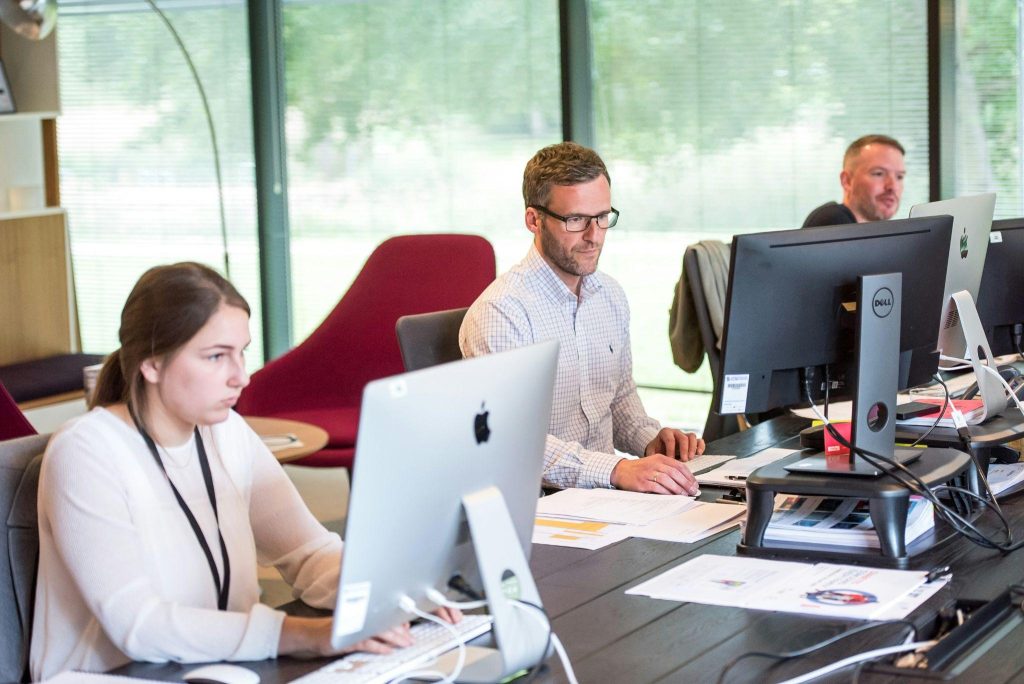For years, companies have poured money into customer experience, digital transformation, and marketing automation—believing those were the surest paths to growth. But in 2025, a new realization has reshaped business thinking: employee experience (EX) isn’t just a “people initiative”—it’s the foundation of sustainable growth. The most successful customer experiences are built by employees who feel valued, connected, and empowered to make a difference. When people thrive at work, innovation and service excellence naturally follow.
According to Gallup, organizations with highly engaged employees outperform their peers by 21% in profitability and experience significantly lower turnover rates. This isn’t a coincidence; it’s evidence that engagement fuels productivity, creativity, and resilience. When employees feel a sense of purpose and psychological safety, they contribute ideas, collaborate openly, and take ownership of results. In today’s hyper-competitive environment, the quality of employee experience has become one of the strongest predictors of organizational success and long-term performance.
The Shift From Workforce to Work Experience
Traditional management viewed employees as resources to be optimized. But the new era of business sees them as experience builders—the people who create value, shape culture, and influence customer outcomes daily. The pandemic accelerated this shift. Remote work, flexible schedules, and digital collaboration changed what employees expect from work—and what companies must deliver.
Employee experience today encompasses far more than perks or paychecks. It’s about creating an environment where people feel psychologically safe, have clarity in purpose, and see growth opportunities aligned with their values. In this model, productivity isn’t enforced—it’s inspired.
When leaders invest in these areas, they don’t just retain talent; they unleash creativity and commitment that translate directly into business performance.
|
“Growth doesn’t begin in the marketplace; it begins in the mirror. Companies that obsess over customer satisfaction but overlook employee experience eventually hit a ceiling. When employees thrive, customers feel it. Happy teams create loyal customers, and that ripple effect is unstoppable.” — Sharon Amos, Director at Air Ambulance 1 |
|---|
Alex’s point echoes a growing truth: EX and CX (customer experience) are two sides of the same coin. When employees are motivated, informed, and empowered, customers feel it too. A strong internal culture radiates outward, shaping every interaction—from sales calls to service support.
The Economic Impact of Employee Experience

Employee experience directly influences the bottom line in ways that are both measurable and transformative. Higher engagement leads to lower absenteeism, stronger collaboration, faster decision-making, and greater accountability across teams. When people feel respected and supported, they bring energy and creativity to their work rather than just meeting the minimum expectations. A well-designed EX strategy doesn’t just make employees happier—it reduces hidden costs such as turnover, presenteeism, and burnout, while amplifying innovation and productivity at scale.
|
“Employee engagement isn’t just an HR metric; it’s an economic one. A disengaged employee quietly erodes profit margins, while an inspired one amplifies them.” — Simeon Genadiev, Managing Partner at The G Law Group. |
|---|
Organizations that embed EX into their culture often see a ripple effect across key performance indicators. Studies by the Corporate Leadership Council reveal that companies with strong EX report 40% fewer quality defects, 37% less absenteeism, and nearly twice the innovation output compared to their peers. These gains translate into faster growth, stronger brand loyalty, and greater resilience during market disruptions.
Employee experience, when treated as a strategic pillar rather than a human resources initiative, becomes the ultimate performance driver. It aligns people with purpose, optimizes operational flow, and turns daily work into a source of value creation—not just labor expenditure.
The Link Between Culture and Competitive Advantage
EX and CX (customer experience) are two sides of the same coin, and one cannot thrive without the other. When employees are motivated, informed, and empowered, customers feel it in every interaction—whether it’s through the tone of a service call, the attention to detail in a product, or the empathy shown during a problem resolution. The emotional energy inside an organization inevitably reflects in the experience it delivers outside. In essence, the way a company treats its people becomes the template for how its people treat its customers.
A strong internal culture acts as the invisible architecture of brand excellence. It radiates outward, influencing not only customer satisfaction but also innovation, communication, and long-term loyalty. Companies that prioritize purpose-driven cultures create a sense of shared mission that fosters agility and collective resilience. When employees understand the “why” behind their work, they adapt faster, collaborate better, and take ownership of outcomes that serve both the business and the customer.
Why Employee Experience Is the Silent Multiplier
What makes EX such a powerful but often invisible growth driver is its compound effect. The benefits aren’t always immediate, but they scale exponentially. Let’s break down three major ways EX directly fuels business growth:
1. Productivity and Innovation
When employees feel heard, trusted, and supported, they go beyond completing assigned tasks—they start contributing meaningful ideas that drive progress. A culture rooted in trust transforms the workplace from a hierarchy into a creative ecosystem. Research by MIT Sloan found that companies fostering high-trust environments experience 50% higher productivity and 76% more engagement in innovation initiatives. This is largely because psychological safety allows employees to take calculated risks without the fear of criticism or blame.
When people feel safe to challenge ideas or suggest improvements, they bring forward new perspectives that management might otherwise overlook. This openness fuels faster problem-solving, continuous learning, and a willingness to experiment. Frontline employees, in particular, often see inefficiencies and customer pain points first, making their contributions a goldmine for innovation.
|
“Innovation isn’t a department; it’s a mindset. When people feel safe to share ideas, small sparks of creativity compound into meaningful growth.” — Suhail Patel, Director of Dustro. |
|---|
These micro-innovations—small, everyday improvements—add up over time, turning an organization from reactive to proactive and helping it stay ahead of competitors in both efficiency and creativity.
2. Talent Retention and Attraction
In today’s competitive labor market, culture has become the new currency of attraction and retention. Top performers are no longer swayed by salary alone—they seek clarity in expectations, recognition for their efforts, and a genuine sense of belonging. They want to work for organizations that see them as contributors, not headcount. Companies that invest in employee experience (EX) send a powerful message: “You matter here.” That sense of value becomes the deciding factor between a team that stays and one that leaves.
Organizations that prioritize EX are magnets for high-value talent because they create environments where people can do their best work without compromising their well-being or purpose. Replacing an employee can cost up to twice their annual salary when factoring in lost productivity, training, and recruitment. Beyond the financial toll, turnover disrupts team cohesion, drains institutional knowledge, and slows innovation.
When employees grow with the business, they develop a deeper understanding of systems, clients, and culture—assets that no new hire can immediately replicate. Over time, this shared experience compounds into stronger morale, higher trust, and better performance across the board.
|
“Retention is built on trust. When employees see that their leaders are genuinely invested in their growth, they stop looking elsewhere and start building what’s next.” — Allen Liu, Tech Lead & Content Specialist of FreSound. |
|---|
3. Customer Loyalty and Brand Reputation
Customers can sense when an organization’s people care about what they do. An engaged workforce delivers consistent, empathetic service—and that consistency builds brand trust. Think of companies like Ritz-Carlton or Zappos: their reputation didn’t come from ads but from the genuine enthusiasm of employees living the brand every day.
The ripple effect is profound. A positive employee experience doesn’t just create happier teams—it generates authentic brand ambassadors that no marketing campaign can replicate.
|
“Employee experience has become a core business strategy. It now shapes innovation speed, customer satisfaction, and long-term revenue strength. Leaders who fail to design for experience are, by default, designing for attrition.” — Daniel Battaglia, Founder and CEO of Parking Cupid |
|---|
Most organizations measure performance in numbers, not emotions. Yet emotions drive effort, creativity, and retention—the very factors behind long-term growth. The solution isn’t more data dashboards but human-centered leadership, where managers act as experience architects, not task supervisors.
Technology’s Role in Enhancing Employee Experience
Modern employee experience (EX) is becoming increasingly data-driven, combining technology with human insight to create workplaces that are both efficient and empathetic. Artificial intelligence, automation, and analytics platforms now give leaders real-time visibility into employee sentiment, workload balance, and engagement trends. Tools such as Microsoft Viva, CultureAmp, and Qualtrics EX are turning raw feedback into actionable insights, enabling HR teams to detect friction points—like burnout risks or communication gaps—before they escalate into resignations.
Automation is also helping reduce what many call “digital fatigue.” AI-driven workflows and virtual assistants are handling repetitive administrative tasks, scheduling, and reporting, allowing employees to redirect their time toward creative and strategic work. This shift not only boosts productivity but also enhances job satisfaction, as employees feel trusted to focus on higher-value contributions.
|
“Technology won’t solve experience on its own, but it shows where it cracks. The smartest leaders blend analytics with empathy to intervene before people disengage.” — Kellon Ambrose, the Managing Director at Electric Wheelchairs USA. |
|---|
Ultimately, technology doesn’t replace empathy—it amplifies it. By combining data-driven insights with human-centered leadership, organizations can listen better, adapt faster, and personalize experiences at scale, creating workplaces where people genuinely thrive.
Designing for Employee Experience
Building a great employee experience isn’t a one-time initiative—it’s an ongoing design process. Here are the key pillars companies are focusing on to build growth through EX:
1. Clarity and Communication
Employees thrive when they understand the “why” behind their work. Transparency from leadership helps connect everyday tasks to larger company goals. Regular communication, open feedback channels, and shared progress reports turn strategy into shared ownership.
2. Growth and Learning Opportunities
Career stagnation is one of the fastest paths to disengagement. Leading companies are embedding learning into work—offering reskilling programs, microlearning platforms, and mentorship initiatives that enable employees to grow alongside the organization.
This investment not only builds capability but also signals trust when people see that their development matters; they give their best in return.
3. Well-Being and Flexibility
In the modern workplace, well-being isn’t a perk—it’s productivity infrastructure. Burnout and fatigue directly impact business results. Flexible work arrangements, realistic workloads, and mental health support create environments where employees can perform sustainably.
4. Recognition and Empowerment
Recognition has one of the highest ROI in employee experience. Simple acknowledgments of effort or peer-based recognition programs foster belonging. Empowerment means giving people autonomy to make decisions—transforming them from executors into co-creators of success.
|
“Employee experience is the compound interest of culture. It builds quietly over time until it defines your future. Every moment counts. Ignore them, and progress fades.” — Anna Zhang, Head of Marketing at U7BUY. |
|---|
This analogy is powerful because it reframes EX as an investment portfolio. Every positive interaction adds value, while every neglected one erodes trust. Over time, that trust compounds into resilience, adaptability, and innovation—traits that define market leaders.
Measuring What Matters: The New EX Metrics

Traditional engagement surveys are no longer enough to capture the dynamic nature of modern workplaces. Today’s organizations are shifting toward continuous, real-time measurement of employee experience through sentiment analysis, employee Net Promoter Scores (eNPS), and lifecycle feedback loops. These tools offer a clearer, ongoing picture of how employees feel, work, and grow within the company. Metrics such as belonging index, internal mobility rates, and well-being scores are helping leaders connect the dots between human experience and measurable business performance.
|
“Measurement drives improvement. Turning employee experience into data transforms culture from a feeling into a business strategy.” — Grant Aldrich, Founder & CEO of Preppy. |
|---|
Forward-thinking organizations now leverage predictive analytics to identify early signs of burnout, declining engagement, or shifting sentiment. By catching these signals early, they can act proactively—adjusting workloads, improving communication, or offering support—before performance or morale declines. This data-driven approach transforms EX from a reactive process into a strategic advantage, ensuring employees feel supported, valued, and continuously understood.
Leadership as the Experience Catalyst
Leaders today are more than decision-makers—they’re the architects of employee experience. Their behavior, empathy, and communication style shape how teams feel, function, and perform. In this new era of work, leadership is defined not by authority but by connection. When leaders listen actively, communicate with transparency, and follow through on their commitments, they build psychological safety and trust—the foundation of every thriving culture.
Modern employees look to their leaders for clarity, fairness, and authenticity. A consistent, empathetic leader can turn corporate values from wall art into lived experience. When people feel seen and supported, they’re far more likely to bring their best selves to work, share ideas openly, and go the extra mile for their teams and customers alike.
Where trust flows downward, innovation rises upward—and that’s where leadership becomes the ultimate driver of employee experience.
The Business Case for EX-Focused Growth
Let’s be clear: employee experience (EX) isn’t a soft or intangible concept—it’s a measurable, strategic differentiator that directly drives financial performance. A Deloitte report revealed that organizations prioritizing EX outperform competitors by 2.4 times in revenue growth, demonstrating a clear correlation between employee satisfaction and profitability. Leading companies like Salesforce and HubSpot attribute much of their success to people-first cultures, where engagement, empowerment, and empathy are embedded into everyday operations.
The rise of AI-driven analytics has made it possible to quantify experience with unprecedented precision. From real-time sentiment tracking and workload balance to collaboration data and learning metrics, technology is transforming intuition into insight. With these tools, HR leaders and executives can detect friction points early and design environments where people thrive.
In the modern workplace, sustainable growth depends not just on innovation or capital, but on how deeply organizations invest in the people behind them.
Final Thoughts: Growth Starts Within
The future of business growth isn’t built on automation or technology alone—it’s built on alignment between people, purpose, and performance. True scalability happens when employees feel deeply connected to the company’s mission, have the resources to grow, and are trusted to lead within their roles. When individuals understand how their contributions drive the bigger picture, engagement turns into ownership, and that ownership fuels innovation and agility across the organization.
Employee experience is no longer a background initiative—it’s the silent engine that powers every thriving business. It shapes culture, strengthens trust, and creates the momentum that keeps teams motivated even through uncertainty. Companies that recognize this early don’t just grow; they evolve organically and sustainably from within. In a world where technology levels the playing field, it’s the human experience—how people feel, think, and connect—that will define the next generation of business success.





















